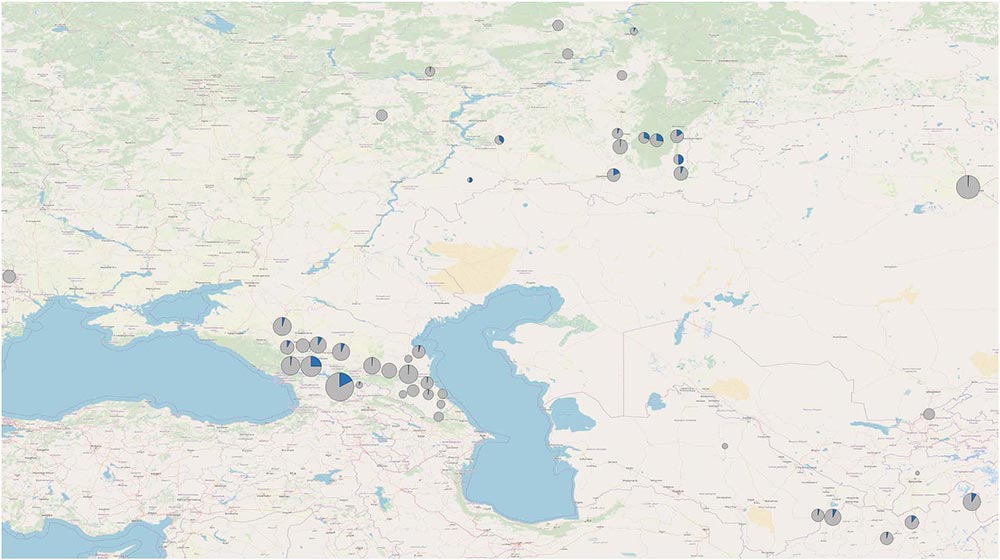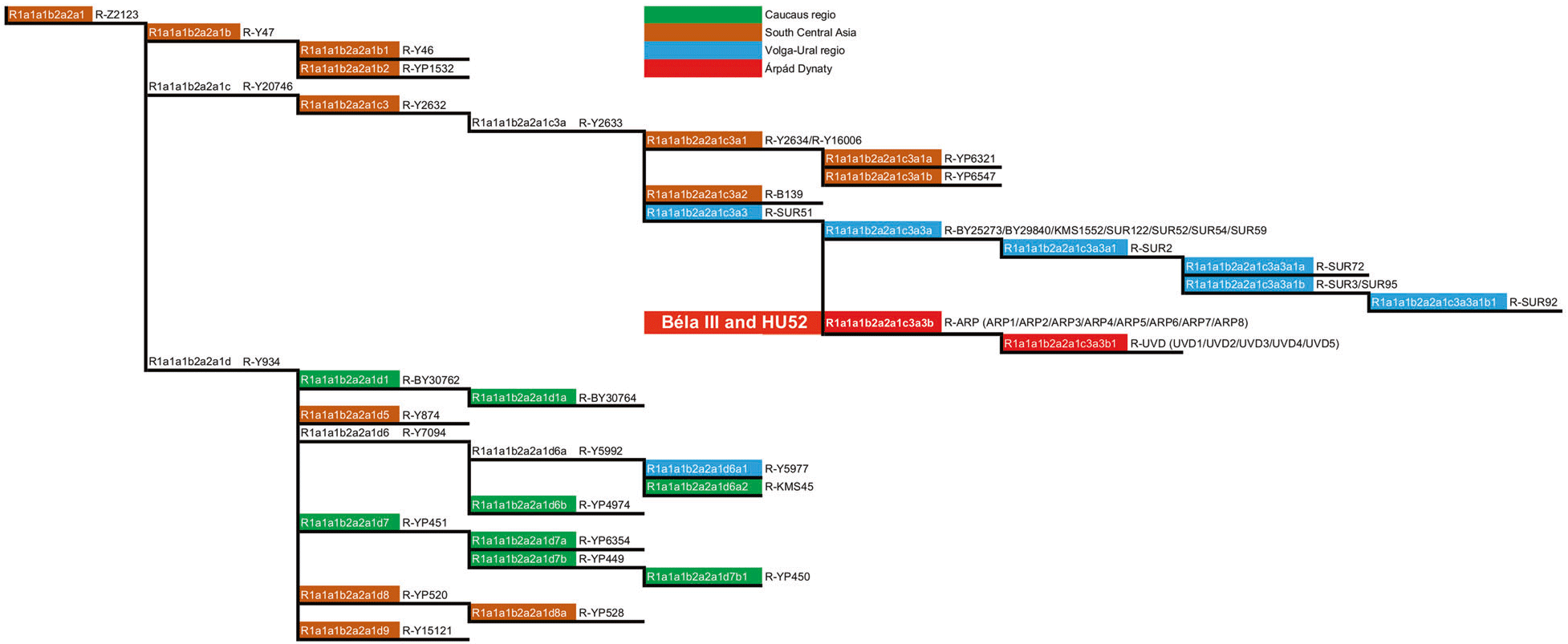Recent paper (behind paywall) Genetic evidence suggests a sense of family, parity and conquest in the Xiongnu Iron Age nomads of Mongolia, by Keyser, Zvénigorosky, Gonzalez, et al. Human Genetics (2020).
Interesting excerpts (emphasis mine):
Site and bodies
The Tamir Ulaan Khoshuu (TUK) cemetery is located near the confluence of the Tamir River and the Orkhon River in the Arkhangai Aimag (Central Mongolia), about four hundred kilometers west of the capital of Mongolia, Ulaanbaatar. It encompasses an area of 22 hectares located on a prominent granitic outcrop and comprises a total of 397 graves, delimited by stone circles. (…) Radiocarbon (14C) dates to the cemetery between the first century BC and the first century AD (Poznan Radiocarbon Laboratory), in the middle of the Xiongnu period. The 48 excavated graves yielded the remains of 57 individuals, specifically 21 males, 17 females and 19 of undetermined sex. Although most of the graves were single (individual) graves, seven contained the remains of two or three individuals. Moreover, four of them (07, 13A, 14A and 14B) were attributed to culturally Turkic individuals.
An exceptional genealogy detected by autosomal STR profiles
Visual comparison of the profiles in pairs and LR analyses revealed the presence of first-degree (parent–offspring and full-sibling) and second-degree relatives in the TUK cemetery. As parent–offspring relationships have been shown to be the only relationships systematically reliably detected by the LR method applied to this number of STR (Zvénigorosky et al. 2020), we focused on these relationships and identified five nuclear families (composed of the parents and one or two children) (TUK-01,-02C,-03,-26; TUK23,-19,-18; TUK-36,-34,-48,-25; TUK-25,-13B,-40; TUK-40,-32,-11). All of them were part of a five-generation familial structure composed of 19 individuals and represented in Fig. 2:

Sixteen individuals (some closely related to one another) were affiliated to sub-haplogroup (sub-Hg) R1a, among which 10 (TUK-04, -09A, -09B, -10, -12, -25, -35, -36, -40 and -48) belonged to Hg R1a- Z2125 and 4 (TUK-08,-18,-23 and -37) to Hg R1a-Z95. Five individuals were affiliated to sub-Hg Q1a-M120. Two individuals belonged to Hg N, one to sub-Hg J1 and one to sub-Hg G1. The last one could not be assessed with certainty
(…) matches with ancient samples reaching 80% of shared alleles have been considered and were reported in Table S6. The highest scores were obtained for the Xiongnu individuals affiliated to Hg R1a. Most of them showed Y-haplotypes close to those of Iron Age male individuals from the Krasnoyarsk region (Keyser et al. 2009).
- The closest haplotypes (a single difference on 16 or 17 Y-STR loci) were observed between TUK09A and TUK10 and individuals S26 and S28 from the Tagar culture (Keyser et al. 2009). Matches were also observed with Middle Bronze Age male individuals of the same area (eg. TUK10 shared a 14 Y-STR haplotype with individuals S10 and S16 from the Andronovo culture).
- Close matches were also found with 2 Scytho-Siberians from the Tuva Republic (ARZ-T1,-T28) (Mary et al. 2019). The database search also revealed a shared haplotype (14 Y-STR) between TUK-09A,-10 and King Béla III (1172–1196), one of the most significant rulers of the first Hungarian dynasty (Olasz et al. 2019) as well as a matching haplotype (15 Y-STR) between TUK-12,-35 and another male individual found in the Royal Basilica where King Béla III was buried (II/54).
- Individuals TUK-9A,-10,-18 and -23 also carried haplotypes similar to those carried by the tenth century Hungarian Conquerors (KEII/61 and NF/2) (Fóthi et al. 2020), whereas TUK-36 and -48 could be linked to a warrior (a commoner) found in the Tavan Tolgoi graves (1130–1250 AD) of the Mongol imperial family (MN376) (Lkhagvasuren et al. 2016). Finally, TUK12 was found to share at least eight Y-STR with a Xiongnu individual from the Egyin Gol Valley (Keyser- Tracqui et al. 2003).
- Interestingly, TUK-13A (considered to be Turkic), carried a Y-haplotype (Hg N) shared with the eighteenth century Yakut individuals (up to a single difference on 17 Y-STR loci) (Table S6), seventh–eighth century Avar individuals (up to a single difference on 14 Y-STR loci) (Csáky et al. 2020) and a tenth century Hungarian Conqueror (on 13 Y-STR) (Fóthi et al. 2020). No close matches were found for the other Xiongnu males, possibly due to the small number of ancient Y-STR haplotypes included in the database (n = 369).

Discussion
All R1a1a haplotypes among our TUK samples are closely related and were attributed to sub-Hgs R1a1a1b2a-Z95 or R1a1a1b2a2a-Z2125. Both are subclades of R1a1a1b2-Z93, considered to be the Asian branch of the R1a1a haplogroup that would have originated in the Eurasian steppes (Pamjav et al. 2012; Haak et al. 2015). Most of these haplotypes were very close to those of Southern Siberian Middle Bronze or Iron Age individuals from the Krasnoyarsk region (Keyser et al. 2009) and the Tuva Republic (Mary et al. 2019) confirming the presence of Andronovo or Scytho-Siberian ancestry in the Xiongnu, as previously suggested (Damgaard 2018) Moreover, these haplotypes also matched those of ancient Hungarian rulers or invaders (Olasz et al. 2019; Fóthi et al. 2020), which might indicate the persistence of some Xiongnu paternal lineages in the gene pool of early Hungarian conquerors.
Some further haplotype-level matches were observed between the Turkic carrier of the Y-Hg N (TUK13A) and Avars as well as Yakuts from the seventh and fifteenth–nineteenth centuries, respectively. This Turkic haplotype, affiliated to Hg N1a1 or N-Tat (Keyser et al. 2015; Csáky et al. 2020), could indicate that the Avars originated from people living in the Mongolian and Baikal area as previously suggested (Csáky et al. 2020). It could also provide the first direct evidence that the Turkic-speaking Yakuts originated from the same area.
In their study, Neparáczki et al. (2019) showed that east Eurasian R1a subclades R1a1a1b2a-Z94 and R1a1a1b2a2-Z2124 were a common element of the Hun, Avar and Hungarian Conqueror elite and very likely belonged to the branch that was observed in our Xiongnu samples. Moreover, haplogroups Q1a and N1a were also major components of these nomadic groups, reinforcing the view that Huns (and thus Avars and Hungarian invaders) might derive from the Xiongnu as was proposed until the eighteenth century but strongly disputed since (De la Vaissière 2005).

Hg. R1a-Z2123 and N1c and the Turkic expansions
The results of this paper seem to correct the recent open access paper by Nagy, Olasz, Neparáczki, et al. Eur J Hum Genet (2020):
(…) the coalescence estimation using the Clustal Omega software suggests that the Z2123* starburst (appearance of R-YP3920, R-YP4907, R-Y47, R-Y934, and R-Y2632) occurred ~4500 years ago. This likely occurred in the region centered on northern Afghanistan since all Z2123* individuals of our cohort, as well as individuals belonging to the early branches of the R-Y47 (R-46), R-Y934 (R-Y874*, R-Y15121*, R-YP520*) and the R-Y2632 haplogroups (R-Y2634 and R-Y16006; RYP6321*; R-YP6547*) are seen predominantly in Afghan individuals. The more derived haplogroups of RY2632, (R-SUR51) and R-Y934 (R-YP451 and R-Y5977) are to be found in the Volga Ural and the Caucasus regions, respectively, suggesting a founder effect and a relatively recent population expansion at their current locations.
Our analysis indicates that the ancestral lineage of modern Bashkirs separated from the lineage of the Árpáds about 2000 years ago marked by the appearance of the R-ARP haplogroup. (…) Based on the genetic analysis of two members of the Árpád Dynasty, it appears that they derived from a lineage (R-Z2125) that is currently predominantly present among ethnic groups (Pashtun, Tadjik, Turkmen, Uzbek, and Bashkir) speaking Iranian or Turkic languages.

Their estimation of a “Northern Afghan” origin of the spread of haplogroup R1a-Z2123 (see FTDNA and YFull data), as suggested by the modern distribution of its subclades, is contradicted by the finding of STR coincidences within ancient samples derived from the Uralic-speaking Andronovo-like horizon, such as those from Solenoozernaïa IV in Krasnoyarsk and Oust-Abakansty in Khakassia (ca. 1800-1400 BC), those from the (likely Samoyedic-speaking) Tagar culture, and the (likely Turkic-speaking) Xiongnu, Huns and Avars. This suggests that some modern subclades – at least those related to Avars or Hungarian Conquerors – became first integrated among Iranian-speaking Scythians and (Micro-Altaic-speaking??) Scytho-Siberian peoples.
Interestingly, both founder effects reported in the paper, of “Turkic” R1a-ARP and “Finno-Ugric” N1c-B539 subclades (see Post et al. 2019) appear to coincide in time, ca. 2000 ybp and later, suggesting that both lineages spread with nomadic populations during the Iron Age, giving thus oxygen to the Turanian connection of Magyars.
As I recently commented, the findings of highly admixed Iron Age Iranian and Turkic peoples spreading westward through the Eurasian steppes and forest-steppes, coupled with modern descendants prevalent among Turkic-speaking peoples (and now with the findings of this paper) seem to contradict my earlier simplistic attribution of N-Z1936 expansion to Bronze Age Finno-Ugric populations, but it is still possible that they became integrated first among Corded-Ware-derived Finno-Ugrians around the Urals and only later expanded with nomads, similar to what happened with these R1a-Z2125 subclades.
Related
- N-Z1936 thrived around the Urals in the Middle Ages
- R1b-rich Proto-Indo-Europeans show genetic continuity in Asia
- More Hungarian Conquerors of hg. N1c-Z1936, and the expansion of ‘Altaic-Uralic’ N1c
- Ancient phylogeography: spread of haplogroups R1b, R1a and N
- Uralic speakers formed clines of Corded Ware ancestry with WHG:ANE populations
- Magyar tribes brought R1a-Z645, I2a-L621, and N1a-L392(xB197) lineages to the Carpathian Basin
- R1a-Z280 and R1a-Z93 shared by ancient Finno-Ugric populations; N1c-Tat expanded with Micro-Altaic
- The complex origin of Samoyedic-speaking populations
- Corded Ware—Uralic (IV): Hg R1a and N in Finno-Ugric and Samoyedic expansions
- Corded Ware—Uralic (III): “Siberian ancestry” and Ugric-Samoyedic expansions
- The traditional multilingualism of Siberian populations